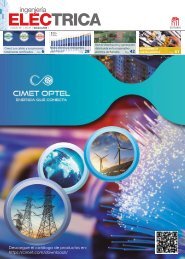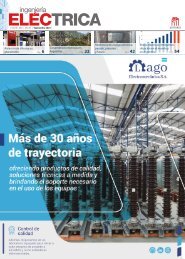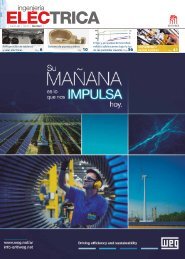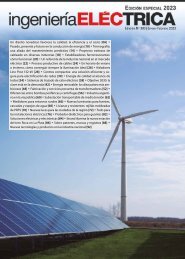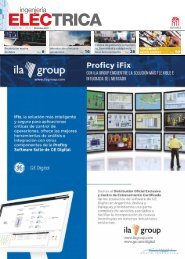Luminotecnia 149 | Abril - Junio 2020
Create successful ePaper yourself
Turn your PDF publications into a flip-book with our unique Google optimized e-Paper software.
Artículo técnico<br />
campamento, el comienzo de la secreción de melatonina<br />
ocurrió más cercano a la caída del sol y la eliminación,<br />
del amanecer, alineando alondras y búhos con la<br />
duración de la luz natural. En sus conclusiones establecen<br />
que “la mayor exposición a la luz solar podría ayudar<br />
a reducir las consecuencias en la salud de la disrupción<br />
circadiana”. <br />
Referencias<br />
[1] Stevens, R.G.; Zhu, Y. Electric light, particularly at night, disrupts<br />
human circadian rhythmicity: Is that a problem? Philos.<br />
Trans. R. Soc. B Boil. Sci. 2015, 370, 20140120. [CrossRef]<br />
[PubMed]<br />
[2] Wurtman, R.J. The Effects of Light on the Human Body. Sci.<br />
Am. 1975, 233, 68–77. [CrossRef]<br />
[3] Guido, M.E.; Garbarino-Pico, E.; Contín, M.A.; Valdez, D.J.;<br />
Nieto, P.S.; Verra, D.M.; Acosta-Rodríguez, V.; De Zavalía, N.;<br />
Rosenstein, R.E. Inner retinal circadian clocks and non-visual<br />
photoreceptors: Novel players in the circadian system.<br />
Prog. Neurobiol. 2010, 92, 484–504. [CrossRef] [PubMed]<br />
[4] Glickman, G.; Levin, R.; Brainard, G.C. Ocular input for human<br />
melatonin regulation: Relevance to breast cancer. Neuroendocrinology.<br />
2002, 23, 17–22.<br />
[5] Cajochen, C. Alerting effects of light. Sleep Med. Rev. 2007,<br />
11, 453–464. [CrossRef]<br />
[6] CIE. Report on the First International Workshop on Circadian<br />
and Neurophysiological Photometry, 2013. 2015. Available<br />
online: http://files.cie.co.at/785_CIE_TN_003-2015.pdf<br />
(accessed on 19 March <strong>2020</strong>).<br />
[7] Erren, T.C.; Reiter, R.J. Light Hygiene: Time to make preventive<br />
use of insights—old and new—into the nexus of the<br />
drug light, melatonin, clocks, chronodisruption and public<br />
health. Med. Hypotheses 2009, 73, 537–541. [CrossRef]<br />
[8] Cho, C.-H.; Lee, H.-J.; Yoon, H.-K.; Kang, S.-G.; Bok, K.-N.;<br />
Jung, K.-Y.; Kim, L.; Lee, E.-I. Exposure to dim artificial light<br />
at night increases REM sleep and awakenings in humans.<br />
Chrono Int. 2015, 33, 1–7. [CrossRef]<br />
[9] Sancar, A.; Lindsey-Boltz, L.; Kang, T.-H.; Reardon, J.T.; Lee,<br />
J.H.; Ozturk, N. Circadian clock control of the cellular response<br />
to DNA damage. FEBS Lett. 2010, 584, 2618–2625.<br />
[CrossRef]<br />
[10] Madrid Pérez, J.A.; Rol de Lama, M.Á. Ritmos, relojes y relojeros.<br />
Una introducción a la Cronobiología. Eubacteria 2015,<br />
33, 1–7.<br />
[11] Schroeder, M.M.; Harrison, K.R.; Jaeckel, E.R.; Berger, H.N.;<br />
Zhao, X.; Flannery, M.P.; Pierre, E.C.S.; Pateqi, N.; Jachimska,<br />
A.; Chervenak, A.P.; et al. The Roles of Rods, Cones, and Melanopsin<br />
in Photoresponses of M4 Intrinsically Photosensitive<br />
Retinal Ganglion Cells (ipRGCs) and Optokinetic Visual<br />
Behavior. Front. Cell. Neurosci. 2018, 12. [CrossRef] [Pub-<br />
Med]<br />
[12] Wong, K.Y.; Dunn, F.A.; Berson, D. Photoreceptor Adaptation<br />
in Intrinsically Photosensitive Retinal Ganglion Cells. Neuron<br />
2005, 48, 1001–1010. [CrossRef] [PubMed]<br />
[13] Garaulet, M.; Madrid, J.A. Chronobiology, genetics and metabolic<br />
syndrome. Curr. Opin. Lipidol. 2009, 14, 127–134.<br />
[CrossRef] [PubMed]<br />
[14] Pandi-Perumal, S.R.; Srinivasan, V.; Spence, D.W.; Moscovitch,<br />
A.; Hardeland, R.; Brown, G.M.; Cardinali, D.P. Ramelteon:<br />
A review of its therapeutic potential in sleep disorders.<br />
Adv. Ther. 2009, 26, 613–626. [CrossRef]<br />
[15] Der Lek, R.F.R.-V.; Swaab, D.F.; Twisk, J.; Hol, E.; Hoogendijk,<br />
W.J.; Van Someren, E.J. Effect of Bright Light and Melatonin<br />
on Cognitive and Noncognitive Function in Elderly Residents<br />
of Group Care Facilities. JAMA 2008, 299, 2642. [CrossRef]<br />
[16] Khan, Z.; Labala, R.K.; Yumnamcha, T.; Devi, S.D.; Mondal, G.;<br />
Devi, H.S.; Rajiv, C.; Bharali, R.; Chattoraj, A. Artificial Light<br />
at Night (ALAN), an alarm to ovarian physiology: A study of<br />
possible chronodisruption on zebrafish (Danio rerio). Sci.<br />
Total Environ. 2018, 628–629, 1407–1421. [CrossRef]<br />
[17] Koo, Y.S.; Song, J.-Y.; Joo, E.Y.; Lee, H.-J.; Lee, E.; Lee, S.K.;<br />
Jung, K.-Y. Outdoor artificial light at night, obesity, and<br />
sleep health: Cross-sectional analysis in the KoGES study.<br />
Chrono Int. 2016, 33, 301–314. [CrossRef]<br />
[18] Martín, C.S.; Sánchez-Muniz, F.J. Chronodisruption and cortisol<br />
and melatonin imbalance, a probable prelude of most<br />
prevalent pathologies? J. Negat. No Posit. Results 2017, 2,<br />
619–633. [CrossRef]<br />
[19] Abbas, K. Handbook of life stress, cognition and health. Behav.<br />
Res. Ther. 1990, 28, 104. [CrossRef]<br />
[20] Mirick, D.K.; Davis, S. Melatonin as a Biomarker of Circadian<br />
Dysregulation. Cancer Epidemiol. Biomark. Prev. 2008, 17,<br />
3306–3313. [CrossRef] [PubMed]<br />
[21] Figueiro, M.; Steverson, B.; Heerwagen, J.; Yucel, R.; Roohan,<br />
C.; Sahin, L.; Kampschroer, K.; Rea, M. Light, entrainment<br />
and alertness: A case study in offices. Light. Res. Technol.<br />
2019. [CrossRef]<br />
[22] Correa, Á.; Barba, A.; Padilla, F. Light Effects on Behavioural<br />
Performance Depend on the Individual State of Vigilance.<br />
PLoS ONE 2016, 11, e0164945. [CrossRef] [PubMed]<br />
[23] Smolders, K.C.; De Kort, Y. Bright light and mental fatigue:<br />
Effects on alertness, vitality, performance and physiological<br />
arousal. J. Environ. Psychol. 2014, 39, 77–91. [CrossRef]<br />
[24] Chang, A.-M.; Scheer, F.A.J.L.; Czeisler, C.A.; Aeschbach,<br />
D. Direct Effects of Light on Alertness, Vigilance, and the<br />
Waking Electroencephalogram in Humans Depend on Prior<br />
Light History. Sleep 2013, 36, 1239–1246. [CrossRef]<br />
[25] Wright, K.P.; McHill, A.W.; Birks, B.R.; Griffin, B.R.; Rusterholz,<br />
T.; Chinoy, E.D. Entrainment of the human circadian clock to<br />
the natural light-dark cycle. Curr. Boil. 2013, 23, 1554–1558.<br />
[CrossRef]<br />
Nota del editor. El presente artículo es una traducción llevada a<br />
cabo por Alejandra Bocchio de un extracto del artículo “Towards a<br />
Sustainable Indoor Lighting Design: Effects of Artificial Light on the<br />
Emotional State of Adolescents in the Classroom”, de Sustainability.<br />
38 <strong>Luminotecnia</strong> <strong>149</strong> | <strong>Abril</strong> - <strong>Junio</strong> <strong>2020</strong> |





